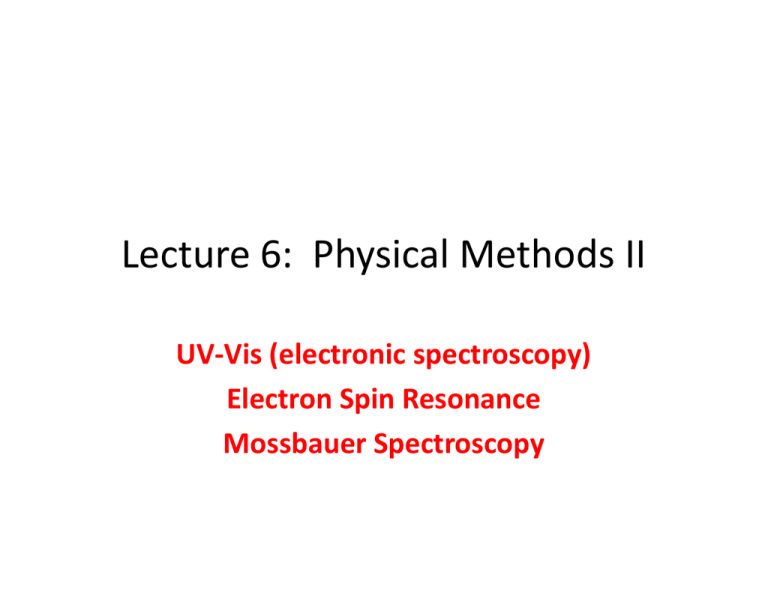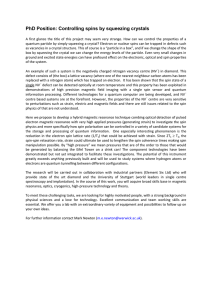Lecture 6: Physical Methods II UV‐Vis (electronic spectroscopy) Electron Spin Resonance Mossbauer Spectroscopy
advertisement

Lecture 6: Physical Methods II UV‐Vis (electronic spectroscopy) Electron Spin Resonance Mossbauer Spectroscopy Physical Methods used in bioinorganic chemistry X‐ray crystallography X‐ray absorption (XAS) • Extended X‐ray Absorption Fine Structure (EXAFS) • X‐ray Absorption Near Edge Structure Magnetic Resonance • Electron paramagnetic resonance (EPR) • Nuclear magnetic resonance (NMR) • Mössbauer (MB) • Optical Spectroscopy: • Electronic absorption (UV‐vis) • Circular dichroism (CD) • Magnetic circular dichroism (MCD) • Luminescence (fluorescence & phosphorescence) • Infrared (IR) • Resonance Raman (RR) • Electrochemistry Spectrum of Electromagnetic Radiation MB XAS UV‐vis CD/MCD Lumin. IR RR EPR (e‐spin) NMR A Reminder: UV-Visible Spectroscopy • Absorption of UV‐vis results in transitions of electrons from a lower energy occupied MO to a higher energy unoccupied MO • Widely used method for identification of inorganic and organic species Electronic transitions π, σ, and n electrons d and f electrons Charge transfer reactions π, σ, and n (non-bonding) electrons Chromophore ‐ part of a molecule that absorbs UV/Vis light H C H2C CH3 C H CH2 C H CH2 n->π* (324 nm) π -> π* Vacuum UV : 10 – 200 nm Normal : 200 – 400 nm Visible : 380 – 780 nm O π->π* (219 nm) 176 nm 178 nm 223 nm 5 E = hυ = hc/ λ E ∝ 1/λ = wavenumber (cm‐1) d-d transitions • Δ value dependent upon ligand field strength – Br‐ < Cl‐ < F‐ < OH‐ < C2O42 ‐~ H2O < SCN‐ < NH3 < en < NO2‐ < CN‐ – Δ increases with increasing field strength • Δ increases with increasing charge on TM • Δ increases with 2 and 3rd row TM Electron transitions Chromophore ‐ part of a molecule that absorbs UV/Vis light H C H2C CH3 C H CH2 C H CH2 n->π* (324 nm) π -> π* Vacuum UV : 10 – 200 nm Normal : 200 – 400 nm Visible : 380 – 780 nm O π->π* (219 nm) 176 nm 178 nm 223 nm 10 H C H2C C H CH2 11 d‐d transitions – 3d and 4d 1st and 2nd transition metal series – Broad transitions; small molar absorptivity coefficients (these transitions are formally “forbidden”) Charge transfer bands • • • High energy absorbance – Energy greater than d‐d transition • Electron moves between orbitals – Metal to ligand – Ligand to metal • Sensitive to solvent LMCT – High oxidation state metal ion – Lone pair ligand donor MLCT – Low lying pi, aromatic – Low oxidation state metal • High d orbital energy Metal‐based UV‐vis terms UV‐vis Spectral Characteristics of Heme Proteins Protein Trp/Tyr metMb oxyMb Heme Soret Visible Different types of hemes heme a heme b heme c d -d transitions • Binding ligands on axis has greater effect on axial orbitals Electron Paramagnetic Resonance (EPR) Electron Spin Resonance (ESR) Electron Magnetic Resonance (EMR) EPR ~ ESR ~ EMR Molecules with one or more unpaired electron – Quantum mechanics: unpaired electrons have spin and charge and hence magnetic moment – Electronic spin can be in either of two directions (formally up or down) – The two spin states under normal conditions are energetically degenerate – Energy degeneracy lost when exposed to an external magnetic field www.healthcare.uiowa.edu/research/sfrbm/Papers/Sunrise%20Papers/Workshop%20Papers/2005/Gunther%202005.ppt www.mcw.edu/FileLibrary/Groups/FreeRadicalResearchCenter/otherfile/EPRBasics.ppt Ms = +½ Energy Ms ±½ ΔE = hν = gβB Ms = -½ B=0 h ν g β B ΔBpp B>0 Planck’s constant 6.626196 x 10-27 erg.sec frequency (GHz or MHz) g-factor (approximately 2.0) Bohr magneton (9.2741 x 10-21 erg.Gauss-1) magnetic field (Gauss or mT) EPR is the resonant absorption of microwave radiation by paramagnetic systems in the presence of an applied magnetic field Magnetic Field (B) hν = gβB ν= (gβ/h)B = 2.8024 x B MHz for B = 3480 G for B = 420 G for B = 110 G ν = 9.75 GHz (X-band) ν = 1.2 GHz (L-band) ν = 300 MHz (Radiofrequency) The hyperfine effect • The magnetic field experienced by the unpaired electron is affected by nearby nuclei with non-zero nuclear spin Weil, Bolton, and Wertz, 1994, “Electron Paramagnetic Resonance”, New York: Wiley Interscience. Electron Nucleus I (½) S (½) Ms MI +½ +½ Hyperfine Coupling a -½ MS=±½ ΔE1 -½ ΔE2 -½ B “doublet” +½ E = gβBSz + (hA0)SzIz E = gβBSz + (a)SzIz (hA0 (Hz) -> a (G) via gfactor) Selection Rule ΔMS = ±1 (electron) ΔMI = 0 (nuclear) ΔE1 = gβB + a/2 ΔE2 = gβB - a/2 ΔE1 – ΔE2 = a Electron Hyperfine Coupling Nucleus I (1) S (½) Ms MI +½ +1 +0 -1 a MS=±½ ΔE1 ΔE2 ΔE3 B -½ E = gβBSz + (hA0)SzIz E = gβBSz + (a)SzIz (hA0 (Hz) -> a (G) via gfactor) -1 +0 +1 Selection Rule ΔMS = ±1 (electron) ΔMI = 0 (nuclear) “triplet” ΔE1 = gβB + a ΔE2 = gβB ΔE3 = gβB - a EPR Ferromagnetic coupling: S = S1 + S2 Antiferromagnetic coupling: S = S1 - S2 Which one is EPR active: Fe(III)-NO or Fe(II)-NO? EPR Spectra of Ferrous Porphyrin-Fe-NO 14N, I=1 15N, I =1/2 14NO O N Fe(II) N 15NO N O 14NO N Fe(II) 15NO N N 3040 3200 MAGNETIC FIELD (GAUSS) 3360 6 Coord. Zhao, X.; Yeung, N.; Russell, B.S.; Garner, D.K.; Lu, Y. J. Am. Chem. Soc., 126, 6766-6767 (2006). Mössbauer Spectroscopy (Nuclear Gamma Ray Resonace) EPR Mossbauer Mossbauer: a nuclear phenomena involves the absorption of photons by nuclei, causing transitions from ground nuclear spin states to excited states (e.g. I = ½ to I = 3/2 in 57Fe) 57Fe, 57Co I = 3/2 Utility: 14.41 keV - the oxidation states, coordination environments, spin states of iron ions. - number of irons in a cluster or enzyme - spin coupling phenomena in iron clusters 57Fe, I = 1/2 57Fe, 57Fe, Absorbing 57Fe sample I = 3/2 I = 1/2 Isomer shift (δ, mm/s): the energy of actual transition minus the energy at 0 mm/s; reflects the magnitude of the electron density at the nucleus Determined by -oxidation state of the iron -nature of the iron-ligand bonds -the coordination number about the iron ion e.g. Fe2+(SR)4, δ = 0.7 mm/s; Fe3+(SR)4, δ = 0.3 mm/s Quadrupole splitting (ΔEQ): the electric field gradient (EFG) -the electrons about the nucleus, thus indirectly about the oxidation state of the Fe -the ligand field about the nucleus For high spin Fe(II) and Fe(III), which one has bigger ΔEQ? Typical ΔEQ: for Fe(II) is 3 mm/s, for Fe(III) is 0.3 mm/s Nuclear Zeeman Interaction: the nuclear spin can interact with a magnetic field, like that of electron spin in EPR Sextet with cubic symmetry: No EFG N M N −M =0 Sextet without cubic symmetry: Presence of EFG N −M ≠0 N M Spectrum of Electromagnetic Radiation MB XAS UV-vis CD/MCD Lumin. IR RR EPR (e-spin) NMR UV-Visible Spectroscopy Absorption of UV-vis results in transitions of electrons from a lower energy occupied MO to a higher energy unoccupied MO Widely used method for identification of inorganic and organic species Electronic transitions π, σ, and n electrons d and f electrons Charge transfer reactions π, σ, and n (non-bonding) electrons



